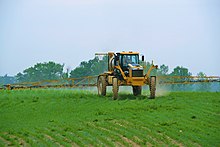Pesticide application: Difference between revisions
Roy Bateman (talk | contribs) Contents obscured |
No edit summary |
||
| Line 5: | Line 5: | ||
[[Image:1919 sprayer.jpg|thumb|right|Spraying a fruit orchard, [[Tooele County, Utah]], 1919]] |
[[Image:1919 sprayer.jpg|thumb|right|Spraying a fruit orchard, [[Tooele County, Utah]], 1919]] |
||
[[Image:RomaniaAgricultureSprayer.JPG|thumb|right|Tractor Sprayer ]] |
[[Image:RomaniaAgricultureSprayer.JPG|thumb|right|Tractor Sprayer ]] |
||
[[Image:8103_Liquid_Terragator.JPG|thumb|right|Large Self-Propelled 'Floater' Sprayer]] |
|||
[[Image:1264_Rogator_Spraying_Corn.JPG|thumb|right|Self-Propelled Row-crop Sprayer]] |
|||
== Spray application == |
== Spray application == |
||
Revision as of 01:50, 13 February 2009
- For related pages, see aerial application, sprayer, spraying and spray nozzle.
Pesticide application is often highly inefficient, but practical efforts to improve the situation are rare; however, this may change with increased concerns about health and environmental effects (Matthews, 2006).





Spray application
Pesticide application is often associated with spraying - in the form of manual equipment (illustrated), self-propelled or tractor mounted sprayers and aerial application. In terms of dose-transfer to the biological target (i.e. the pest), most pesticide application is highly inefficient (Graham-Bryce, 1977). However, relating "ideal" deposits with biological effect is fraught with difficulty (e.g. Hislop, 1987). In spite of Hislop’s misgivings, it is relatively easy to demonstrate that massive amounts of pesticides are wasted by run-off from the crop and into the soil, in a process called endo-drift. This is a less familiar form of pesticide drift, with exo-drift causing much greater public concern. Conventional application using hydraulic atomisers (either on hand-held sprayers or tractor booms) with formulations mixed into high volumes of water, is known to be highly inefficient (e.g. Matthews, 2000).
Some important concepts in spray application
In order to better understand the cause of the spray inefficiency, it is useful to reflect on the implications of the large range of droplet sizes produced by typical (hydraulic) spray nozzles. This has long been recognise to be one of the most important concepts in spray application (e.g. Himel, 1969), bringing about enormous variations in the properties of droplets
Different droplet sizes have dramatically different dispersal characteristics, and are subject to complex macro- and micro-climatic interactions (Bache & Johnstone, 1992). Greatly simplifying these interactions in terms of droplet size and wind speed, Craymer and Boyle (1973) concluded that there are essentially three sets of conditions under which droplets move from the nozzle to the target. These are where:
- sedimentation dominates: typically larger (>100 µm) droplets applied at low wind-speeds; droplets above this size are appropriate for minimising drift contamination by herbicides.
- turbulent eddies dominate: typically small droplets (<50 µm) that are usually considered most appropriate for targeting flying insects, unless an electrostatic charge is also present that provides the necessary force to attract droplets to foliage. (NB: the latter effects only operate at very short distances, typically under 10 mm.)
- intermediate conditions where both sedimentation and drift effects are important. Most agricultural insecticide and fungicide spraying is optimised by using relatively small (say 50-150 µm) droplets in order to maximise “coverage” (droplets per unit area), but are also subject to drift.
Improved targeting
In the 1970s and 1980s improved application technologies such as controlled droplet application (CDA) received extensive research interest, but commercial uptake has been disappointing. By controlling droplet size, ultra-low volume (ULV) or very low volume (VLV) application rates of pesticidal mixtures can achieve similar (or sometimes better) biological results by improved timing and dose-transfer to the biological target (i.e. pest). No atomiser has been developed able to produce uniform (monodisperse) droplets, but rotary (spinning disc and cage) atomisers usually produce a more uniform droplet size spectrum than conventional hydraulic nozzles. Other efficient application techniques include: banding, baiting, specific granule placement, seed tratments and weed wiping.
CDA is good examples of a rational pesticide use (RPU) technology (Bateman, 2003), but unfortunately has been unfashionable with public funding bodies since the early 1990s, with many believing that all pesticide development should be the responsibility of pesticide manufacturers. On the other hand, pesticide companies are unlikely widely to promote better targeting and thus reduced pesticide sales, unless they can benefit by adding value to products in some other way. RPU contrasts dramatically with the promotion of pesticides, and many agrochemical concerns, have equally become aware that product stewardship provides better long-term profitability than high pressure salesmanship of a dwindling number of new “silver bullet” molecules. RPU may therefore provide an appropriate framework for collaboration between many of the stake-holders in crop protection.
Other application equipment
- Motorised mistblowers
- CDA & ULV application equipment
- Foggers
- Granule application equipment
- Dust application
- Application methods for household insecticides
- Seed treatment
See also
- Aerial application
- Aerosol spray
- Formulation
- Integrated Pest Management (IPM)
- Pest control
- Pesticide
- Pesticide drift
- Spray nozzle
- Weed control
References
- Bache D.H., Johnstone, D.R. (1992) Microclimate and spray dispersion Ellis Horwood, Chichester, England.
- Bateman, R.P. (2003) Rational Pesticide Use: spatially and temporally targeted application of specific products. In: Optimising Pesticide Use Ed. M. Wilson. John Wiley & Sons Ltd, Chichester, UK. pp. 129-157.
- Craymer, H.E., Boyle, D.G. (1973) The micrometeorology and physics of spray particle behaviour Pesticide Spray Technology Workshop, Emeryville, California, USA.
- Graham-Bryce, I.J. (1977) Crop protection: a consideration of the effectiveness and disadvantages of current methods and of the scope for improvement. Philosophical Transactions Royal Society London B. 281: 163-179.
- Himel C M (1969) The optimum drop size for insecticide spray droplets. Journal of Economic Entomology 62: 919-925.
- Hislop, E.C. (1987) Can we define and achieve optimum pesticide deposits? Aspects of Applied Biology 14: 153-172.
- Matthews G.A, (2000) Pesticide Application Methods 3rd Edition Blackwell, Oxford
- Matthews G.A. (2006) Pesticides: Health, Safety and the Environment Blackwell, Oxford
